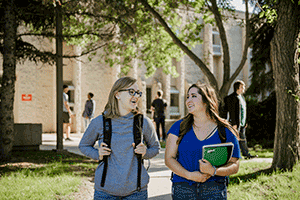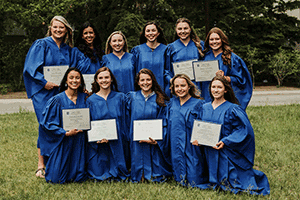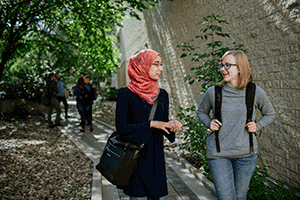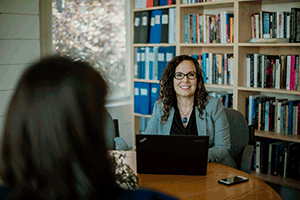Ready to learn more?
Get all the details straight to your inbox!

Our student residence, The Student Village at Luther College, welcomes residents from ALL post-secondary institutions in Regina. Rooms come with a meal plan, free laundry, free wi-fi, and a great sense of community.

Luther College is a great choice for high school to university transition. Enjoy all the benefits of a larger campus, without feeling lost in the crowd. Our community is full of caring mentors and peers to ensure a positive student experience.

Living in The Student Village at Luther College, our student residence, comes with a choice of healthy, nutritious meal plans. That means no grocery shopping, no meals to cook, and no dirty dishes to worry about. You can focus on your studies and wellness!

Luther College students are U of R students and receive all the same benefits. Upon graduation you will receive a U of R degree.

The priority deadline for academic application is March 15. To book a personalized enrolment counselling appointment, contact our Recruitment Office at 1-306-206-2117.

You can book a tour of Luther College, the U of R campus, and our student residence, The Student Village at Luther College, any time throughout the year. Contact our Recruitment Office at 1-306-206-2117.

Free enrolment counselling support and invaluable one-on-one academic advising are available for all programs at Luther College.

Smaller class sizes at Luther College means more individualized attention and better connections with your professors, classmates, and academic advisors.
Get all the details straight to your inbox!
During the winter of 1691-1692 in Salem, Massachusetts, Puritan minister Samuel Parris’ daughter, Elizabeth Parris, and niece, Abigail Williams, began acting strangely. The girls experienced seemingly uncontrollable fits of bodily movements and spoke in unknown languages.[1] Samuel Parris feared that something was medically wrong with the girls, so he called upon the help of a local doctor who said that the girls’ suffering was the result of witchcraft.[2] Tituba, Samuel Parris’ Caribbean slave and the children’s frequent babysitter, was accused of being a witch. She confessed to participating in ritual witchcraft and named her accomplices, Sarah Good and Sarah Osborne, also accused of being witches and hurting the girls.[3] By the end of the nearly year-long outbreak of witch hunts in Salem, two hundred people had been imprisoned and twenty had been killed.[4] During the Salem witch trials of 1692, children’s testimonies were accepted by secular courts - and the Puritan Church - as undeniable evidence of the threat of a demonic attack against the Puritan haven of Salem, Massachusetts. The acceptance of this evidence led to the wrongful imprisonment, conviction, and execution of many innocent citizens.
Salem Village was founded in 1626 near Boston, Massachusetts by agrarian Puritans. The farming community bordered Salem Town, a port town involved in international trade.[5] In 1692, the citizens of Salem Village wanted separation from Salem Town, because the villagers did not want taxes to be spent on matters of trade and expansion, but on local rural issues such as Salem Village’s independence as a church community.[6] The Puritans of Salem Village were known for their strict standards of moral behavior.[7] This high standard caused the Puritans to be more likely than other Christians to keep records of suspected local cases of witchcraft in order to monitor the behavior of fellow townspeople.[8] Stresses other than religious devotion and politics, such as the mysterious dangers of life in the New World, may have led many to accept subsequent accusations of witchcraft in the community during the winter of 1692.
During the seventeenth century, the Massachusetts Bay Colony’s Puritans attempted to maintain awareness of potential signs of God’s displeasure with Salem. Outside of the tensions between Salem Town and Salem Village, political and unknown geographical dangers added to the citizens’ collective stress. War with Indians to the north and the continuous threat of invasion posed by bordering French colonies caused citizens to be in a constant state of fear.[9] Perhaps of most concern to Puritans of Salem was the popular opinion that public religious faith was declining, leading many to be watchful for potentials signs that the Devil, using witches, was mounting an attack against Salem.[10] Colonists’ heightened state of fear may have caused citizens of Salem to be willing to accept children’s accusations of witchcraft.[11]
The Salem witch hunts began in Salem Village near the end of 1691.[12] During the winter of 1691-1692, Samuel Parris’ nine-year-old daughter, Elizabeth Parris, and eleven-year-old niece, Abigail Williams, began acting strangely. After an inconclusive medical examination, the local doctor, William Griggs, determined that the girls’ torment was being caused by witchcraft.[13] The girls’ affliction manifested itself as displays of intense pain, choking, and bodily jerks as if they were being pinched. The girls experienced convulsions and acted like animals, and when adults tried to combat these symptoms through prayer, Abigail would cover her ears, stamp her feet and scream to drown out the presumed holy words. At one point, Elizabeth threw a Bible across the room in a fit of possessive rage. Such strange behavior, inexplicable by seventeenth-century medicine, caused the Puritan community of Salem Village to conclude that the girls’ affliction was being caused by a supernatural entity, and called it bewitchment.[14]
By February, 1692, Reverend Samuel Parris and his Puritan contemporaries pushed Elizabeth and Abigail to name the people who had afflicted them. Under extreme pressure from the adults, the girls accused Tituba, Parris’ Caribbean slave, as well as two other women, Sarah Osborne and Sarah Good.[15] The accusations against Tituba came after she baked a “witch’s cake”, which contained the urine of the afflicted girls and was fed to the Parris’ dog, who was then supposed to be able to track down the witch responsible for the girls’ affliction. Instead, this experiment caused the girls’ fits to worsen.[16]
Tituba initially denied involvement in witchcraft, but stated that in the Barbados, she had been taught how to discover a witch’s true identity.[17] Part five of Robert Calef’s 1700 book, More Wonders of The Invisible World, recalls Tituba’s description of how Samuel Parris extracted her confession:
…her master did beat her … to make her confess and accuse (such as he called) her sister witches, and that whatsoever said by way of confessing or accusing others was the effect of such usage; her master refused to pay her [prison] fees, unless she would stand to what she had said.[18]
The fact that Samuel Parris had to beat a confession out of Tituba suggests that those who endorsed the Salem witch hunts were mistaken in their accusations from the outset. It seems suspicious that the person whom Elizabeth and Abigail accused was Samuel Parris’ slave, Tituba, who would have been in frequent contact with the girls in the Parris home. Tituba seems to have been singled out simply because she was present in the Parris house, and perhaps because of her skin colour. It has been suggested that Tituba may have told the girls Caribbean stories of Voodoo from her home in the Barbados, contributing to the girl’s knowledge of, and potential interest in, possession and magic.[19] Because Tituba was a slave woman, perhaps valued less in Salem, the girls may have decided to single her out as the scapegoat.
Puritan clergyman Cotton Mather influenced the Salem witch trials of 1692. Robert Calef blamed Mather for the development of Salem’s witch craze in his 1700 book, More Wonders of the Invisible World.[20] Mather helped to compile a concise report of the official Puritan opinion of witchcraft, urging for the swift prosecution of suspected witches.[21] Mather’s central role in the Salem witch trials was to ensure that the court did not make any errors in their judgment of suspected witches. Strangely, he suggested that anyone accused of minor charges of witchcraft should be spared from execution if they openly confessed and renounced their pact with the Devil.[22] One of Mather’s books, Memorable Providences Relating to Witchcraft and Possession, detailed a case similar to that of Elizabeth and Abigail, the Goodwin children of Boston, whom Mather had been unsuccessful in freeing from diabolical torment.[23] Mather’s book described how he had convicted an Irish washerwoman known as the Witch Glover of afflicting the Goodwin children. The Witch Glover was eventually tried and hanged.[24] A copy of this book was in the Parris’ home, giving Elizabeth and Abigail access to descriptions of ways a person under the curse of a witch might behave.[25] It is possible that being subjected to details of witch prosecution, and having knowledge of how the afflicted would behave contributed to Elizabeth and Abigail’s seemingly spontaneous development of symptoms of witchcraft affliction.
Tituba’s confession detailed that she had signed a book, stipulating a formal contract with the Devil, which contained nine other signatures, including those of Sarah Good and Sarah Osborne.[26] On March 1, 1692, John Hathorne and Jonathan Corwin questioned Sarah Osborne and Sarah Good at a local inn, an improvised courtroom, which was crowded with curious spectators. The afflicted girls were present during the hearings and cried out in pain during the trials, which was taken as undeniable evidence of their affliction and the guilt of those accused.[27] Sarah Good and Sarah Osborne were the obvious targets of accusations of witchcraft, not being churchgoers, and both fitting the common description of a witch as old, ugly, and ill-tempered.[28] Hathorne and Corwin assumed that those accused of witchcraft, such as Sarah Good and Sarah Osborne, were guilty from the outset.[29]
As a result of the hearings, all three women - Good, Osborne, and Tituba - were sent to jail to await trial to determine their punishment. Sarah Osborne died in prison of unknown causes. Tituba, officially the property of Samuel Parris, and therefore not likely to be executed, was never issued any other punishment.[30] On July 19, 1692, Sarah Good was executed by hanging in a group that included Rebecca Nurse.[31] On March 19, 1692, Abigail had accused Rebecca Nurse, a devoutly religious woman, of being a witch and of asking her to become a witch by signing the Devil’s book.[32] The accusations against presumed righteous citizens like Rebecca Nurse turned the Salem witch hunts into an all-out witch panic, dependant on the acceptance of children’s testimonies. The local fear of witchcraft in Salem was mirrored by a December, 1692 bill Against Conjuration, Witchcraft and Dealing with Evil and Wicked Spirits.[33] That there was legislation to discourage the practice of witchcraft made Salem’s presumed fight against the Devil seem a communal resistance, reliant on the participation of all citizens.
The courts allowed the afflicted girls’ cries of torment during trial to stand as evidence against the accused.[34] This shows the level to which the court relied on the testimony of children. How could the courts be sure that Abigail and Elizabeth had not been faking their conditions? It seems that the court did not concern itself with such debate, and simply accepted the girls’ displays of pain as infallible evidence. It is worth noting that while audiences were attracted to the court hearings to witness the afflicted girls’ displays of possession, there are no records of any possessions taking place in private, away from an audience who would give the children attention and influence their reactions.[35]
The afflicted children were assumed to be able to identify witches by touch. One could be tested to see if he or she was a witch by joining hands with the afflicted child. If the child began to calm down upon joining hands with the subject, then it was assumed that the test subject, the presumed witch who had afflicted the child, had cured the child from its affliction. However, if the child cried out in pain, it would also be assumed that the test subject was a witch.[36] Such evidence seems problematic, since the courts were crowded with spectators, whose collective reaction may have influenced the afflicted girls to cry out in pain when testing a disliked member of the community, thus identifying the disliked person as a witch.
Tests were supplemented with the acceptance of spectral evidence, the theory that the Devil could use the spiritual immaterial form, or spectre, of the accused witch to conduct his evil work. The notion of the spectre accounted for how the accused could be in one place during the time of the alleged crime, in their real-world physical form, and how their spectre could be at the scene of the crime, torturing the afflicted.[37] The fact that it was assumed that one’s spectre was only visible to the afflicted girls shows that such evidence had no defense against. No story would account for the whereabouts of one’s presumed spectre.[38] Courts were simply forced to trust the girls’ stories, about the assumed spectres, without relying on any sort of supporting evidence or tangible witness testimony.
By June of 1692, the jails in the area surrounding Salem were overcrowded with accused witches. On May 27, Governor Sir William Phipps established the Court of Oyer and Terminer, consisting of nine men, including John Hathorne and Jonathan Corwin. The court was to determine the fate of those accused of witchcraft, imprisoned during earlier hearings.[39] By the time the Salem witch hunts concluded, judgments of the Court of Oyer and Terminer had led to the execution of nineteen people by hanging and the death of one man, Giles Corey, for refusing to cooperate during interrogations.[40] Most disturbing about these cases was that the court was profiting from them, since the property of the accused was often seized.[41] To many it may have seemed that no one was safe from the accusations of being a witch.
In October of 1692, Increase Mather, father of Cotton Mather, wrote a document discussing what evidence was valid in a case of witchcraft. His report, Cases of Conscience Concerning Evil Spirits Personating Men, Witchcraft, Infallible Proofs of Guilt in Such as Are Accused with This Crime was presented to fellow clergymen on October 3, 1692. The document concluded that witchcraft should be tried as any other crime, without relying on unsupported spectral evidence, and that the courts should always be cautious in their rulings, stating: “It were better that ten suspected witches should escape, than that one innocent person should be condemned.”[42] Increase’s document influenced Governor Phipps to bring the Court of Oyer and Terminer to an end on October 29, 1692, which, ultimately, ended the Salem witch hunts.[43] At this point, many had lost faith in the witch hunts, since devout individuals, such as Rebecca Nurse, were being accused, which went against the concept of Puritans as faithful supporters of God, not the Devil.[44] Citizens of Salem were ready to give up the fight against the presumed attacks of the Devil.
In 1693, twelve jurymen publicly apologized for the miscalculated judgments during the Salem witch trials of 1692. In 1711, compensation was awarded to many of the victims. By 1957, most of the cases had been resolved and courts had provided compensation to the families of the victims of the Salem witch hunts.[45] Perhaps the Salem witch hunts would not have evolved so quickly to a point of executions if Governor Phipps had not been absent from Salem during the summer, claiming to be addressing the conflicts to the north when he was actually living in Boston.[46] Governor Phipps did not supervise Salem adequately during the witch hunts of 1692 and, as a result, twenty innocent people were put to death and two hundred were imprisoned.[47] During the Salem witch trials of 1692, children’s testimonies were accepted by secular courts and the Puritan Church as undeniable evidence of the threat of a demonic attack against the Puritan haven of Salem, Massachusetts. The acceptance of this evidence led to the wrongful imprisonment, conviction, and execution of many innocent people. Because a court was permitted to be influenced by unsupported spectral evidence and children’s accusations of witchcraft, the Salem witch hunts claimed the lives of twenty innocent victims.
[1] Brian A. Pavlac, Witch Hunts in the Western World: Persecution and Punishment from the Inquisition through the Salem Trials (Westport: Greenwood Press, 2009), 138-139.
[4]Gretchen A. Adams, The Specter of Salem: Remembering the Witch Trials in Nineteenth-Century America (Chicago: University of Chicago Press, 2008), 12.
[5]Robert Rapley, Witch Hunts: From Salem to Guantanamo Bay (Montreal & Kingston: McGill-Queens University Press, 2007), 64.
[12] Carol F. Karlsen, The Devil in the Shape of a Woman: Witchcraft in Colonial New England (New York: Norton, 1987), 36.
[14]Hans Sebald, Witch Children: From Salem Witch-Hunts to Modern Courtrooms (Amherst: Prometheus Books, 1995), 70.
